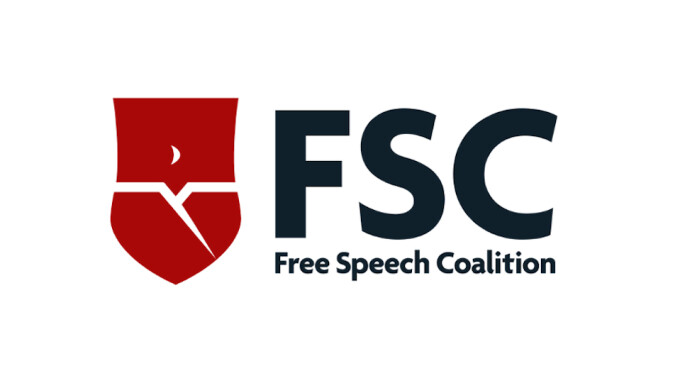LOS ANGELES — The Free Speech Coalition (FSC) held a special town hall on COVID-19 today, addressing the new Cal/OSHA regulations, the rapidly evolving California "Safer at Home" orders and a potential increased risk to adult sets.
The town hall included presentations by FSC Executive Director Michelle L. LeBlanc and Deputy Executive Director Ian O’Brien, who offered short presentations about COVID-19 prevention in the adult industry as of this month. Questions were also fielded from a diverse group of industry participants, including leading producers, agents, performers and industry journalists.
After a brief introduction by LeBlanc, she offered a snapshot of the Cal/OSHA regulations regarding COVID-19 on-site prevention regulations for employers and employees, and a general overview of the situation in Southern California, where many adult productions take place.
“We are in one of those regions of Southern California that is on stricter shutdown orders because we’ve dropped below 15% ICU (intensive care unit) capacity and it’s actually in some areas well below 10%,” LeBlanc commented, adding that she had information that the hospital closest to her was at 0% already and diverting most ER patients to other hospitals.
“Everything is a little wonky,” LeBlanc summarized.
Cal/OSHA's Emergency Temporary Standards
LeBlanc then went over the standing Cal/OSHA Emergency Temporary Standards issued before Thanksgiving, including:
- If you have a workplace in California, these orders do apply to you.
- There are documentation and reporting requirements. If there’s a COVID exposure in your workplace you have to document the exposure and document the investigation of it. If you have three COVID-19 exposures within a two-week period, you have to report that to your local health department.
- If the employee is exposed at work, they need to follow quarantine procedures and you are also obligated to continue to provide salary and any other benefits while the person is quarantined.
- There are also specific regulations about cleaning and precautions that are related to housing and transportation.
- Model houses: According to industry attorney Karen Tynan, this does not apply to model houses if it’s a model house supplied by the agent. But if you’re the producer and you’re providing the model house and transportation, the cleaning regulations do apply. Not necessarily hotels (they have to follow their own guidelines) but they apply to Airbnbs or rentals.
- Base covering and PPE regulations: Nothing above and beyond what was already recommended in FSC health and safety guidelines. If you were following those, you would have already been in compliance with Cal/OSHA.
- Every workplace in California is required to have a COVID prevention plan that you share with employees and that you would be able to share with Cal/OSHA upon request. If an employee asks you for a written plan, you have to be able to provide it to them. In the guidelines there are specific things that you need to include. Counsel has advised not to incorporate the COVID plan into the full version of your IIP (Injury and Illness Prevention) plan, but to add it as an addendum so it can be easily updated as regulations change.
LeBlanc stressed that the FSC-published summary contains a number of complex Cal/OSHA regulations, so employers should familiarize themselves with the summary and the full version and then “talk to an employment lawyer and make sure you’re in compliance.”
Adult Production ‘Not Significantly Impacted’
FSC Deputy Executive Director Ian O’Brien then summarized regional orders in L.A. County and California as a whole, and in other adult production locations like Las Vegas (Nevada) and Florida.
“Part of why we wanted to do this is that there is a lot of information coming from every municipality,” O’Brien explained. “We have the federal government and federal public health agencies saying stuff, we have California state government and public health agencies saying another thing, and then we have our regional jurisdictions in L.A. saying another thing as well. We also have different regulatory bodies coming up with their own guidance.”
“Folks are confused as to how all of this exactly impacts the industry,” he added.
O’Brien confirmed that “largely, adult production — and film production in general — is not significantly impacted by any of the orders that may exist. They’re exempted either explicitly or by the nature of the business through the text.”
The FSC, O’Brien added, is “currently monitoring the major production hubs of Vegas, Florida and California, particularly Los Angeles."
“Las Vegas and Florida don’t have anything that impacts what we do,” he said.
Nevada has extra regulations about film shoots with more than 50 people, O’Brien explained, but nobody should be encouraged to do that right now in any case.
Florida has general recommendations but not requirements, and the governor has blocked municipalities from imposing their own rules.
As for California, O’Brien discussed it is “its own regulatory mess.”
“L.A. 'Safer at Home' orders, for L.A. County went into effect November 30 and will currently remain in effect until December 20,” he explained. The orders restrict public gatherings and reduce business capacity, depending if they’re considered essential or non-essential. This doesn’t impact film production, though producers should be looking at public health guidelines for shoots.
Then there are California’s broader "Regional Stay at Home" orders. Preceding that, O’Brien explained, there was a limited "Stay at Home" order issued by California, which has a curfew for counties that had reached what the state designates as the “Purple Tier” (all of them except some in Eastern California near the Nevada Sierras).
Additionally, on December 3 the state announced the "Regional Stay at Home" orders that were signed December 6. California was divided into five different regions and if a region reached reduced ICU capacity (less than 15%), by midnight the next day they are required to lock down a number of activities, including private gatherings.
But film is exempted, he explained. The industry — music, TV and film — can open with modifications, he added, but should abide by safety protocols agreed upon by labor and management.
“I don’t want to fearmonger,” O’Brien added, “I don’t feel it’s useful. But rates are higher than they have ever been. I am also receiving more reports of COVID on-set than I ever had since the start of the pandemic.”
He clarified that this is not industry-specific. “It’s happening across the board,” mentioning the construction industry as an example of a different line of business that had also seen an increase in viral transmissions. “It’s pandemic-wide,” he said.
As for the adult industry, O’Brien commended “people who are doing protocols, that are doing regular testing, that are reporting, doing contact-tracing and quarantining — we’ve actually done a pretty good job on our sets reducing potential spread.”
Keep Abiding by the FSC's On-Set Reccomendations
As a reminder, O’Brian said the FSC’s original recommendations stand:
- Social distancing (six feet apart whenever possible)
- Using proper PPE
- Face masks should be worn by everyone
- Face coverings on at all times when possible
- Regular testing and strict quarantining
O’Brien also reminded people of the fundamental differences between COVID transmission and testing and STI transmission and testing.
“With our STI testing protocol we can be fairly confident that there will be no presence of HIV and other STIs in a 14-day period,” he said. “When you have a clear test in PASS regarding STIs, there’s a very limited chance that something will appear on set.”
On the other hand, “with COVID, it’s a guess.”
“Testing is helpful, it’s a tool that informs what we’re doing and definitely it’s a harm-reduction approach everyone should continue to take, but we have no guarantees of when transmission will potentially occur.”
“Exposures are not just sex acts, which we can quantify more meaningfully,” he added. “You could get COVID from someone at the grocery store. The number of exposures are greatly increased, the tools we have to detect it are not that sophisticated, and the timelines in which you become infectious and when we have the ability to detect the virus are not the same as STI testing. There is as significant a chance that we could test you one day, it would come back negative, and it doesn’t necessarily mean you don’t have the virus.”
O’Brien responded to a question about frequency, and recommended testing “as close to the shoot as possible,” or “within two days of the shoot.”
“Some folks have been more lax with that,” he admitted, before warning that “right now it’s not the time to be lax. It’s time to be more stringent. The presence of the virus is everywhere. We don’t know exactly how liability is going to fall. We don’t know exactly how it’s going to impact our communities. If you can be more conservative in your testing, [then] be more conservative in your testing.”
O’Brien also spoke about different types of rapid tests that might be introduced into the PASS system in the future.
Current FSC Recommendations in Case of Exposure
O’Brien ended his presentation by summarizing the current FSC recommendations in case of on-set COVID exposure.
These include:
- If you have a COVID positive on one of your set, contact the FSC as soon as possible. “I’ve been working with folks who’ve had COVID-positives on their sets, or if they are agents, one of their talent, and we can help facilitate contact tracing and get you the information you need. It also helps us monitor the health of the industry.”
- Quarantine timelines: CDC guidelines are for general populations. You need to consider them as an employer and you need to make sure you’re in employment compliance. Always follow Cal/OSHA if it disagrees with CDC for liability purposes. Local jurisdiction takes precedence.
- When someone has contracted the virus, either by showing symptoms or testing positive, they need to quarantine for 10 days from either the onset of the symptoms, or from the day of sample collection that resulted in the positive test.
- Folks that have been exposed to people with COVID-19: Most local jurisdictions have adhered to the CDC guideline, which is 14 days to see if the virus develops; 99.9% of infections materialize during that time.
- However, the guidelines have changed: Seven days with a negative test result, 10 days with no test result. If you were exposed to someone with the virus, you get tested again in seven days and if that result comes back negative, you’re cleared for work and you can break quarantine. Otherwise, 10 days if you don’t get tested at all.
- The reason for the change is risk calculation. The industry is made up of a “largely younger group of people who are testing much more frequently than any other industry in the world” using “some of the highest testing standards that we can find."
- For secondary exposure: In the case of three performers (A, B, C) where A worked with B, and then B worked with C the next day, and A tested positive, the FSC recommends that C quarantines for two days while performer B gets retested seven days after the exposure. If B tests negative, C can return to work.
The town hall ended with the FSC’s Michael Stabile encouraging community members to be "sticklers" through this phase of the pandemic, warning the industry that not adhering to the guidelines could result in a sensationalized public scandal after a transmission that would end up “affecting all of us.”








